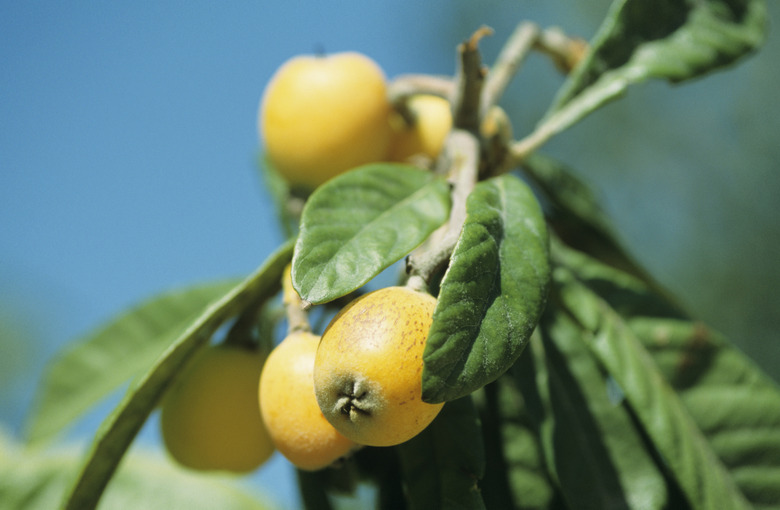How To Grow Loquat Cuttings
Things Needed
- Bowl
- Sphagnum peat moss
- Small knife
- Rooting hormone
- Plastic film
- Twist ties
- Shears
- Planter
- Potting mix
- Shovel
- Fruit-tree fertilizer
Related to pears, apples and the stone fruits, loquat (Eriobotrya japonica) originated in the warm regions of Asia and is now found in South America, the Pacific and the Middle East. Loquat is also adapted to the mild areas of California. The juicy fruit has smooth skin covered with fine, soft hair. This tree has an interesting propagation method from cuttings: After you select the stem for the process, it stays attached to the main plant until its roots develop. Only then do you sever the cutting to plant it. This propagation method is called air layering and works better for loquat trees than the more traditional methods of taking cuttings.
Step 1
Fill a bowl with water and add two handfuls of sphagnum peat moss to it. Let the moss soak while you prepare the loquat cutting.
Step 2
Identify a healthy stem that has grown vigorously, putting out leaves as it goes. Starting at its tip, pluck the foliage along a 6-inch section of wood. Leave the twig attached to the loquat tree for now.
Step 3
Scratch the bark off a 1-inch length in the middle of the cutting with a small knife. The new roots sprout from that section.
Step 4
Dust the exposed wood with rooting hormone.
Step 5
Cut a piece of plastic film large enough to cover the section of the loquat cutting that has no bark. Keep the plastic wrap and a few twist ties within reach.
Step 6
Squeeze the sphagnum peat moss to drain the excess water. Place it over the hormone-treated area of the stem. Hold it in place with one hand as you cover it with the plastic.
Step 7
Wrap a twist tie around the plastic to keep the moss from falling. With that secure, adjust the fit, sealing the peat moss inside the plastic and tightly around the naked section of the stem. Use the twist ties to fasten the plastic cover. This covering keeps the rooting area moist.
Step 8
Treat the loquat tree as usual, watering and feeding it on a normal schedule. Since the cutting is still attached to the plant, it also stays hydrated and fed.
Step 9
Cut the twig off the mother tree after new roots fill the sphagnum peat moss. It usually takes about one month for a dense root system to form. Sever the twig a few inches below the roots.
Step 10
Untie the plastic and discard it. The peat moss entangled with the roots eventually decomposes.
Step 11
Plant the cutting in a container with potting mix. Water it thoroughly. Keep the loquat in the pot until it is established and putting out new growth continuously.
Step 12
Transplant the established loquat sapling to a site in full sun that drains within one hour of irrigation. Dig a hole the same depth as the planter. Water the tree to the root zone.
Step 13
Irrigate the loquat when the ground becomes dry during the growing season. The tree needs moisture to bear a good crop, but it prefers an environment that is on the drier side. The loquat blooms in winter and produces a crop in spring.
Step 14
Select a fertilizer for fruit trees and apply it to the loquat yearly. Follow the directions on the product label for proper rates and application method.
